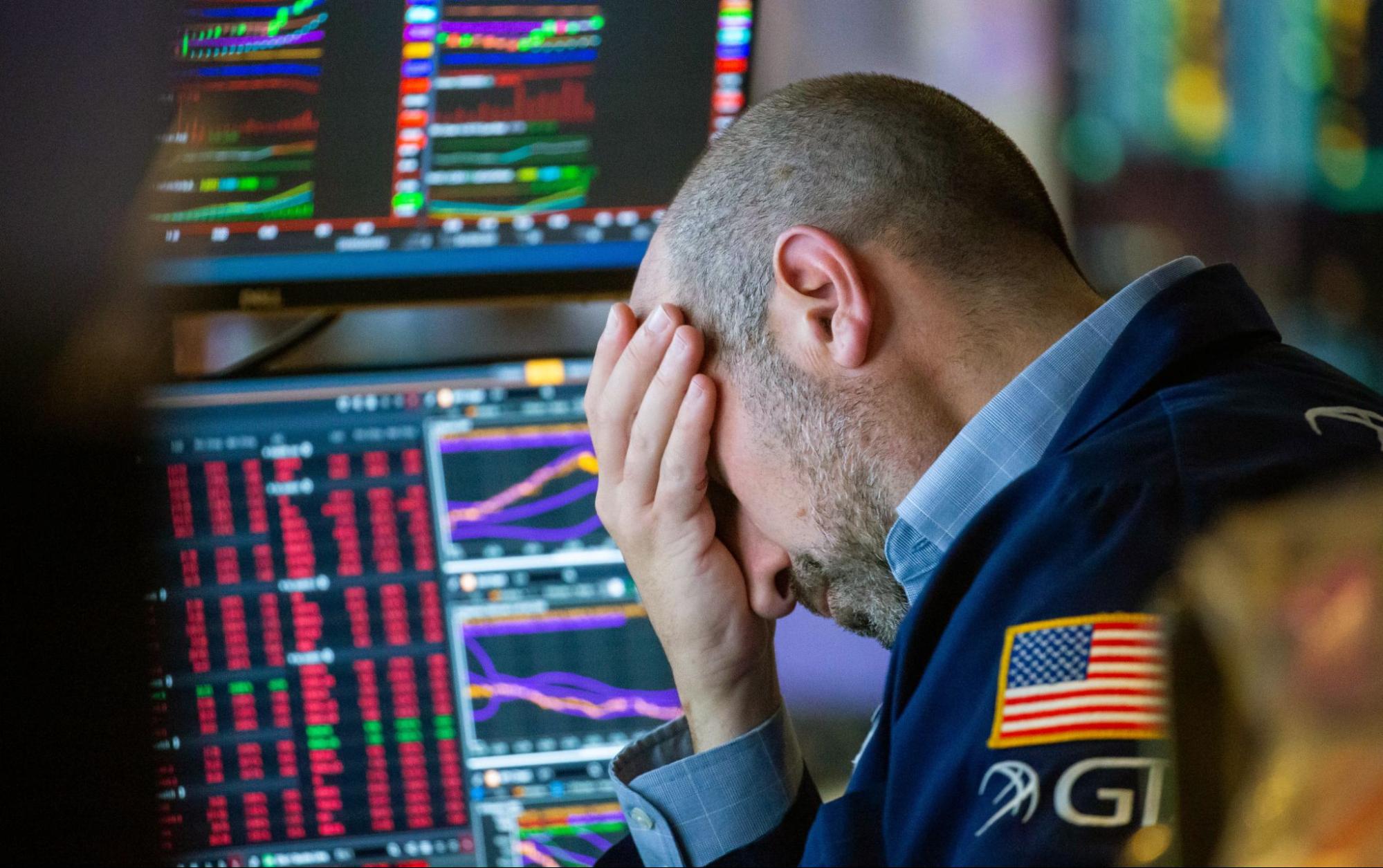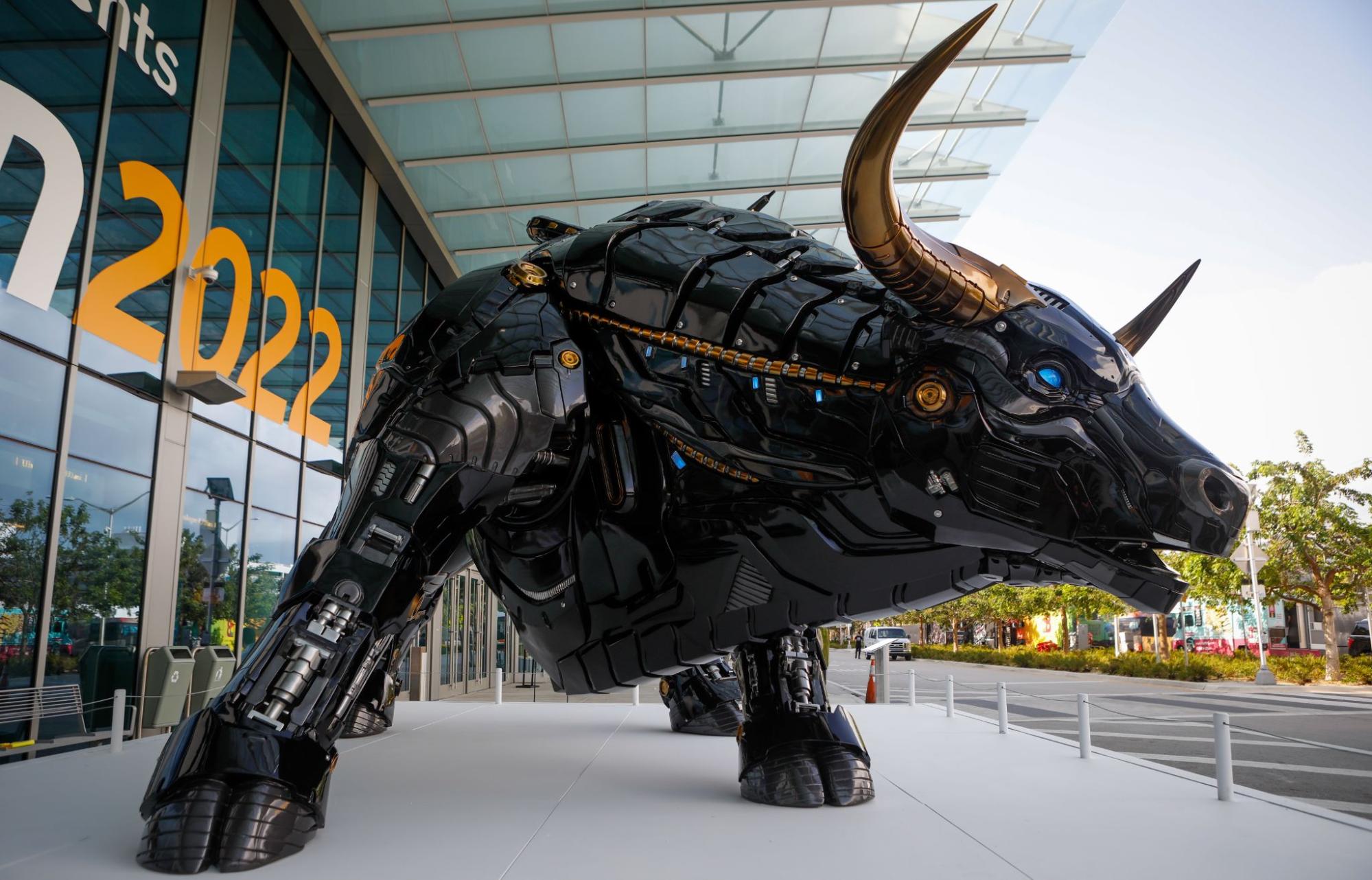The crypto selloff explained

What a headache. The stock and crypto markets continue to endure serious turbulence this week. [Bloomberg via Getty Images]
There’s never a dull moment on the blockchain. Here’s what you need to know this week:
Bitcoin dropped to 2022 lows. Meanwhile a struggling “algorithmic stablecoin” exacerbated market selloff fears. We’ll break it all down.
More U.S. states are embracing crypto. Virginia, Oklahoma, and Texas are among several states making web3 moves.
The week in numbers. The number of websites that could instantly enable DOGE payments and other key stats to know this week.
STABLE STAKES
Markets sag to 2022 lows as crypto world is riveted by a struggling “algorithmic stablecoin”
For months, markets have been shocked by historic inflation, a global supply chain tied in knots, the war in Ukraine, and rising interest rates — including, this week, the Federal Reserve’s biggest rate hike in two decades. In response, crypto and stock prices hit new 2022 lows. But for crypto specifically, the week brought a strange new twist: the struggles of a dollar-pegged stablecoin called TerraUSD (UST), which had recently become the third-largest stablecoin by market cap, with $18 billion in circulation. In recent days, UST has slipped below a dollar, falling as low as 62 cents by Monday night and leading many to wonder if it will survive. We’re breaking down this (complicated!) saga, so buckle up.
Crypto is famously volatile — but stablecoins are designed to hold their value within fractions of a percent. Unlike a more traditional stablecoin like USDC, which is backed by dollar-denominated assets held in segregated accounts with U.S.-regulated financial institutions, UST is backed by another cryptocurrency called LUNA (UST holders are supposed to be able swap each UST for a dollar’s worth of LUNA). The supply of UST and LUNA is dynamically controlled by an algorithm that’s designed to work like a central bank — with the goal of keeping UST’s price steady at one dollar.
Here’s how it’s supposed to work: each time a UST is swapped for LUNA, the UST is burned (or removed from circulation), and vice versa. If UST falls below a dollar, holders are incentivized to make a profit by swapping UST for a dollar’s worth of LUNA — and because the UST is burned, supply is reduced until UST’s value reaches a dollar again. Another tool Terra uses to help boost UST is the decentralized lending protocol Anchor, which is built on the Terra blockchain, and recently offered interest rates around 20% for UST deposits (raising concerns among some critics that such yields were unsustainable).
The exact reason UST became untethered from the dollar remains unclear, but on Saturday, hundreds of millions of dollars worth of both UST and LUNA were rapidly sold across exchanges, pushing UST to around 98 cents. While UST’s price rebounded within hours, the stablecoin’s troubles were just beginning. As panic set in and more holders tried to exit, some reportedly found that they were unable to redeem their UST for the promised $1 in LUNA. Citing “high volume,” Binance also temporarily halted withdrawals of both UST and LUNA. By Tuesday, LUNA — which had been trading above $115 five weeks ago — fell below $25.
What impact have Terra’s struggles had on Bitcoin? Over the last few months, Do Kwon, the founder of the Terra Luna ecosystem, purchased around $3.5 billion worth of BTC via a nonprofit called the Luna Foundation Guard (LFG) to help back the stablecoin — including $1.5 billion added just last week. As The Wall Street Journal reports, analysts believe that BTC’s 10% dip on Monday was triggered in part by holders selling over the weekend out of concern that LFG might begin to divest and flood the market.
Why it matters… The future of the Terra ecosystem remains unclear — UST hovered around 90 cents for much of Tuesday before revisiting 70 cents — but its struggles are a good reminder that there’s no such thing as yield without risk. In a fizzy bull market, it can feel like there’s nowhere to go but up, and in a down market it's easy to panic and bail on all your positions. Which is why we’ve created a guide for managing moments like these, full of useful strategies like dollar-cost averaging. So if you’re feeling a little (or a lot!) jittery, just take a few deep breaths and give it a read:
STATE OF AFFAIRS
States across the U.S. are moving to embrace crypto
While crypto regulation is still a gradual, patchwork effort among various acronymed federal agencies and Congress, a growing list of states and cities (watch out Miami!) are making their own web3 moves — from mining in Fort Worth, Texas to yield farming in Virginia — with a slew of executive orders, bills, and crypto industry studies. Who’s leading the charge? Let’s take a look.
Last week, California Governor Gavin Newsom signed an executive order that aims to spur “responsible innovation” for web3 companies, balancing job creation with regulation. Among the order’s top priorities are creating a “consistent business environment” for crypto tech companies (the industry has long balked at a lack of clarity), researching how to incorporate blockchain tech into state operations, and teaching residents of California — the most populous state in the U.S. — how to prepare for jobs in the growing industry.
Last month, Oklahoma lawmakers advanced a bill to give bitcoin miners tax incentives worth up to $5 million in an effort to attract mining firms. Oklahoma’s bill would exempt commercial mining facilities from taxes on business costs like electricity and equipment for the next fifteen years. The bill would also recognize bitcoin mining as an “industrial process” that gets the tax advantages of “historical forms of manufacturing … to encourage the … expansion of operations in this state rather than in competing states." Meanwhile, Illinois and Georgia are weighing similar actions.
Fort Worth, Texas recently became the first city to start mining bitcoin, after the city council unanimously approved an experimental program that will use three mines (worth $600 each) donated by the Texas Blockchain Council. The mines, which will run 24 hours per day, will add BTC to the city’s balance sheet for the first time and will operate in a climate-controlled room in Fort Worth’s City Hall.
However, New York lawmakers are considering a two-year mining moratorium, preventing mining firms that use non-sustainable energy from renewing operating permits. If the bill passes, New York — home to nearly 10% of Bitcoin’s mining capacity in the U.S. — would be the first state to ban blockchain technology infrastructure. Some in the state say limiting energy-intensive proof-of-work mining would help reach climate goals, while others (including Coinbase) point to the thousands of jobs that would be lost if the bill passes. (Read our article on mining and the environment.)
Why it matters… Financial firms and money managers aren’t the only institutional forces driving crypto adoption. State and local governments are increasingly preparing to embrace crypto-related business opportunities in mining, blockchain tech, and even DeFi. And some are even giving it a whirl themselves. Virginia’s Fairfax County, which has already allocated portions of its pension funds to crypto investments, is looking into the DeFi “degen” strategy known as yield farming. As Katherine Molnar — the chief investment officer of the Fairfax County Police Officers Retirement System — puts it: “We view this as a growth investment.”
NUMBERS TO KNOW
455 million
Total number of WordPress-powered websites — all of which can now theoretically enable Dogecoin payments thanks to a new plugin called Easy Dogecoin Gateway.
$265,500
Amount (90.5 ETH) that Bored Ape parent company Yuga Labs reimbursed NFT bidders after they paid high network fees for failed transactions during a frenzied bidding war for virtual real estate in a forthcoming metaverse game called Otherside.
244
Number of VC funding deals for crypto companies in April, an all-time high. The $4 billion monthly total included a $400 million raise by USDC issuer Circle and a $150 million dollar raise by Sky Mavis, the firm behind Axie Infinity.
TUNE IN
How Vietnam became a global hub for crypto gaming
Even though Axie Infinity exists in its own corner of the metaverse, the pioneering play-to-earn crypto game was developed by a company based in Vietnam. Why is the country such a hotspot for crypto adoption and blockchain gaming? On the latest episode of Around the Block, host Justin Mart sits down with Howard Xu, founder of Ancient8 — Vietnam’s largest blockchain gaming guild — to talk about the future of “GameFi” and why Vietnam is uniquely qualified to lead the next phase of crypto gaming.
TOKEN TRIVIA
Which of the following is not a stablecoin?
A
LINK
B
USDC
C
DAI
D
USDT
Find the answer below.
Trivia Answer
A
LINK











